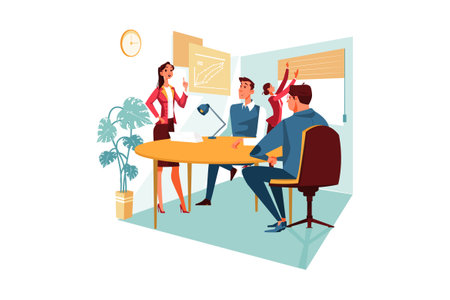Understanding Indian Client Expectations
When working as a freelance interior designer in India, it is crucial to recognise the unique cultural landscape and client expectations that shape every project. One of the most important factors is cultural sensitivity—understanding the diverse traditions, values, and lifestyles of Indian clients. Often, design decisions are not made by an individual but involve the entire family, with elders and multiple generations having a say in the process. This collective decision-making means that your presentations and suggestions should address various preferences and priorities.
Religious considerations also play a significant role. Many clients may have specific requirements regarding prayer rooms (puja rooms), auspicious colours, or placement of certain elements based on their faith. Additionally, following principles of Vastu Shastra, the traditional Indian system of architecture, can be essential for some families. Clients may expect you to incorporate vastu-friendly layouts or avoid specific directions for entrances and rooms.
Demonstrating awareness and respect for these aspects during meetings will help you build trust and rapport with your Indian clients. It sets the foundation for clear communication, smoother collaboration, and ultimately successful project outcomes tailored to their needs.
2. Effective Communication and Building Trust
In the Indian context, effective communication during client meetings is not just about exchanging information; it is about building a strong foundation of trust and understanding. As a freelance interior designer, being clear, transparent, and respectful in your interactions will help you establish lasting relationships with clients.
Clear and Transparent Communication: Start meetings with a polite greeting such as “Namaste” or “Good morning, Sir/Madam.” Always explain your design concepts in simple terms, avoiding jargon unless your client is familiar with design vocabulary. Phrases like “Let me walk you through the plan,” or “Would you like me to clarify any part of the proposal?” are commonly used to keep the discussion open and inclusive. Transparency regarding timelines, costs, and deliverables is crucial. For example, saying “As per our initial discussion, the estimated timeline for this project is six weeks” can help set clear expectations.
Respectful Dialogue: Respect plays a significant role in Indian business culture. Use respectful titles such as “Mr.”, “Mrs.”, or even regional honorifics like “Ji” after names (e.g., “Suresh Ji”). Listen actively by nodding and maintaining appropriate eye contact—this shows that you value their input. Avoid interrupting when clients are speaking; instead, use phrases like “I completely understand your point” or “Thats a very good suggestion.”
Body Language Nuances:
| Gesture | Meaning | Best Practice |
|---|---|---|
| Nodding | Agreement/Understanding | Nod gently when listening to show engagement |
| Slight Smile | Politeness/Friendliness | Maintain a pleasant demeanor throughout the meeting |
| Avoiding Direct Eye Contact (Briefly) | Respect/Humility | If a client looks away briefly while talking, it may indicate respect rather than disinterest |
| Hand Gestures (Open Palms) | Openness/Honesty | Use open palm gestures to convey transparency and willingness to help |
Localised English Phrases:
- “Kindly let me know your thoughts.”
- “We can take it forward as per your convenience.”
- “Please feel free to suggest any changes.”
- “I hope everything is up to your expectations.”
- “If you have any doubts, do let me know.”
By mastering these strategies for clear communication and cultural nuances, you will not only build trust but also ensure smoother project execution and satisfied clients in the Indian market.
![]()
3. Showcasing Your Portfolio the Indian Way
When presenting your portfolio as a freelance interior designer in India, it’s crucial to curate your work in a way that truly connects with local clients and their cultural sensibilities. Indian aesthetics are rich, layered, and full of diversity, so your presentation should reflect these aspects.
Highlight Indian Design Elements
Showcase past projects that incorporate traditional Indian elements such as jaali patterns, intricate woodwork, or vibrant wall colours. Clients often appreciate when you include heritage touches like brass fixtures, ethnic textiles, or hand-painted tiles. Mention any use of vastu shastra principles or how you’ve balanced modern design with Indian traditions.
Diverse Spaces Matter
India’s homes and offices range from compact city apartments to sprawling bungalows and joint family houses. Tailor your portfolio presentation to include a variety of spaces: modular kitchens for urban flats, puja rooms with traditional decor, multifunctional living areas, and balconies transformed with greenery. This assures clients that you understand the unique requirements of different Indian lifestyles.
Use Local Materials & Styles
Clients in India increasingly value sustainability and regional authenticity. Highlight your experience working with local materials—like Rajasthan marble, South Indian teakwood, or terracotta tiles. If you have designed using indigenous crafts (such as Madhubani art or Warli paintings), make sure to point these out. Explain your process for sourcing from local artisans, which not only supports the community but also creates designs that feel truly “at home” in India.
By thoughtfully adapting your portfolio for the Indian context and showing an understanding of both contemporary trends and traditional values, you will build credibility and trust with potential clients during meetings and presentations.
4. Handling Budget and Negotiations
In the Indian context, managing budgets and navigating negotiations are crucial skills for any freelance interior designer. Here are some effective strategies to ensure transparent pricing and successful client relationships:
Transparent Pricing: Building Trust from the Start
Always present your pricing structure clearly and in writing. Indian clients appreciate transparency and often expect a detailed breakdown of costs. Use the following sample table as a template for presenting your budget proposal:
| Item | Description | Estimated Cost (INR) |
|---|---|---|
| Design Consultation | Initial concept meeting & site visit | 5,000 |
| 3D Visualisation | Rendering of proposed designs | 8,000 |
| Furniture & Materials | Sourcing & procurement support | 50,000 |
| Labour Charges | Civil, carpentry & installation work | 40,000 |
| Total Estimate | 1,03,000 |
Managing Cost Expectations: Avoiding Misunderstandings
Set realistic expectations early on by discussing possible variations due to material choices or market price fluctuations. Clearly communicate what is included and excluded in your scope of work. It’s common for Indian clients to expect “jugaad” (creative solutions), so be prepared with alternative options at different price points.
Example Approaches for Different Budgets:
- Tight Budget: Suggest cost-effective materials or phased implementation.
- Mid-Range Budget: Balance quality with affordability using a mix of branded and local products.
- Premium Budget: Offer exclusive designs, high-end finishes, and international brands.
Navigating Negotiations: Understanding Indian Style Bargaining
Bargaining is deeply rooted in Indian business culture. Clients may expect discounts or added value (“something extra”) as part of the deal. Stay polite yet firm—explain your value proposition and where you can be flexible without compromising on quality. Consider offering:
- A small complimentary service (e.g., free design revision)
- A bundled package discount if multiple rooms or services are booked together
- An early-bird discount for immediate confirmation or advance payment
Pro Tip: Document Everything!
Summarise every agreement in writing—use email or WhatsApp messages to confirm revised quotes or special offers. This ensures clarity and avoids disputes later in the project lifecycle.
5. Presentation Etiquette and Meeting Set-Up
Creating a positive first impression during client meetings is crucial for freelance interior designers in India. Begin by greeting your clients with traditional Indian hospitality. A respectful “Namaste” with folded hands or a warm handshake, depending on the client’s comfort, sets the right tone. Always address clients politely using ‘Mr.’, ‘Ms.’ or their professional titles, as this demonstrates respect for Indian cultural norms.
Serving Chai or Coffee: Hospitality Matters
Offering refreshments is an integral part of Indian client meetings. Serving chai (tea) or coffee, along with some light snacks like biscuits or namkeen, not only reflects thoughtful hosting but also helps build rapport. Ensure your refreshments are ready before your clients arrive, and ask about their preferences to add a personal touch.
Offline Presentation Set-Up
For in-person meetings, ensure your presentation space is clean, comfortable, and well-lit. Arrange seating to encourage easy conversation—preferably facing each other around a table. Have physical samples of materials, swatches, mood boards, and printed portfolios ready for tactile engagement. Test all devices in advance: laptop connections, projector screens, and any digital displays should work seamlessly to avoid interruptions.
Online Presentation Best Practices
If you’re meeting virtually, choose a quiet background free from distractions and clutter. Dress professionally, just as you would for an offline meeting. Share presentations via screen share and send relevant files beforehand for smoother discussions. Use video conferencing tools that are popular in India, such as Google Meet or Zoom. Always check your internet connection prior to the meeting to avoid delays and technical glitches.
Ensuring Client Comfort
Whether offline or online, always ask your clients if they are comfortable with the set-up and pace of the meeting. Encourage questions and feedback throughout the presentation. By blending traditional Indian hospitality with modern professionalism, you can create a welcoming environment that fosters trust and collaboration.
6. Following Up and Maintaining Relationships
After a successful client meeting, the real magic begins with thoughtful follow-up and relationship management. In the Indian freelance interior design market, building trust and strong bonds is crucial for long-term success and repeat business. Here are some practical tips tailored to India’s unique business culture:
Timely Follow-Ups Show Professionalism
Always send a follow-up message or email within 24 hours of your client meeting. Express gratitude for their time and reiterate your understanding of their needs. If you discussed any specific requirements or changes, summarize these points clearly. This step demonstrates reliability—a key value in Indian business circles.
Personalized Thank You Notes Make an Impact
Go beyond standard emails by sending personalized thank you notes, either digitally or, if appropriate, as a handwritten card. Address the client by name and mention something specific from your discussion. In India, such gestures are appreciated as they reflect genuine respect and interest in the relationship, not just the transaction.
Maintain Ongoing Communication
Don’t disappear after the meeting! Share regular updates on project progress through WhatsApp messages or quick phone calls—both popular communication methods in India. Ask for feedback at each milestone, ensuring clients feel involved and valued throughout the design process.
Building Referral-Driven Networks
Happy clients can be your best brand ambassadors. Politely ask satisfied clients for referrals or testimonials once a project concludes successfully. Consider offering referral incentives like a small gift or complimentary consultation for every new client they introduce. Word-of-mouth recommendations carry significant weight in Indian communities and can open doors to new opportunities.
Celebrate Indian Festivals & Special Occasions
Acknowledge major Indian festivals (like Diwali or Holi) by sending festive greetings to your clients via SMS or e-cards. These small but thoughtful touches help deepen relationships and keep you top-of-mind for future projects.
Nurture Relationships Beyond Projects
Stay connected with past clients even after projects end. Share design tips, invite them to industry events, or simply check in during important occasions. By nurturing these relationships, you create a loyal client base that is more likely to recommend your services within their extended networks—a powerful growth strategy in India’s relationship-driven market.

